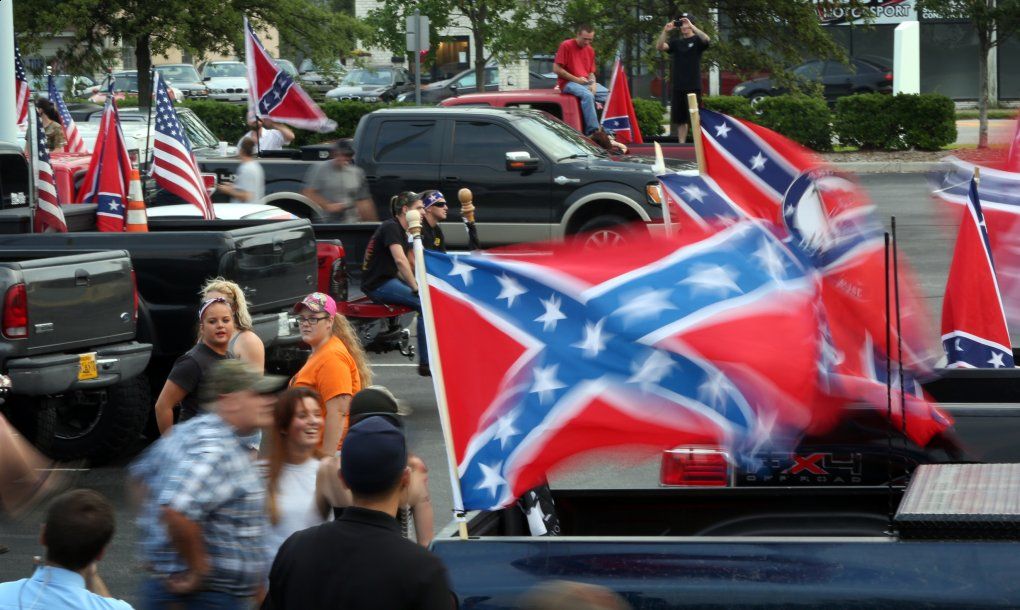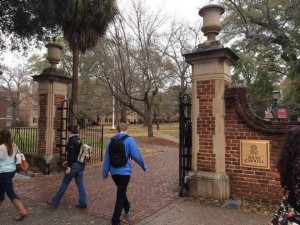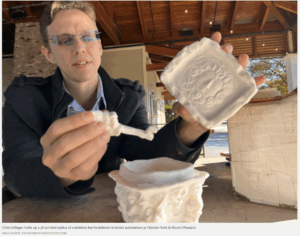SOUTH CAROLINA: USC Students Protest Alleged Inequalities
COLUMBIA, S.C. — University of South Carolina students protesting alleged inequalities at the university planned to stage a walk out and protest Monday morning as a part of continued protests at other universities nationwide.
The “USC 2020 Vision” group began an online petition called “Here’s No Place Like Home”which outlines 12 demands to President Harris Pastides for minority groups at the university. The petition called for students to walk out of class at 11 a.m. Monday to participate in a protest at the Longstreet Theatre, before marching to the Osborne Administration Building near the Horseshoe.
“In order to meet the following demands, we are asking that the university create a diverse, representative, knowledgeable Student Board of Trustees,” the petition read. “This board will oversee the implementation of our vision before the year 2020. Additionally, to carry out these initiatives, we ask that the university use its many diversity committees to aid in the follow up required for these demands. Show us that you truly believe in no limits at the University of South Carolina.”
Among the demands, which included greater minority recruitment as well as the building of gender-neutral facilities, the group called for an independent investigation into several of the university’s top officials, but the group does not say why those officials should be investigated.
In a statement released from Pastides Friday, he asked for students to “pause and reflect on the events taking place on college campuses across the country and the environment that exists on our own campus.”
“We appreciate our students making their voice heard, participating in civil discourse and continuing the dialogue toward making our campus a safe and welcoming environment for all students. The issues they have raised will do much to guide the conversation. In fact, many are already being addressed or are included in the university’s strategic plans.
We have been planning a new initiative designed to host further dialogue and conversation directed toward action, the South Carolina Collaborative on Race and Reconciliation under the direction of our Chief Diversity Officer, Dr. John Dozier. Provost Gabel and Dr. Dozier are incorporating diversity and inclusiveness as part of our measurable campus progress. We are creating a new leadership distinction in social justice to encourage individual and societal efforts to improve the lives of all. The Social Compact Task Force that has been meeting this semester is addressing many of these issues as well, and a full report and recommendation is expected in the spring semester. Just to name a few.”
We remain steadfastly committed to improving our institution for the benefit of all members of the Carolina family. The leadership and opinions of these students are welcome and much appreciated. We look forward to addressing their concerns as we move forward in creating a safe, welcoming and comfortable environment in which all Gamecocks can thrive—ensuring that we are inclusive in the process of determining next steps and taking action.”
–thestate.com
###
GEORGIA: Protestors Hike Stone Mountain With Flags
A small group of Confederate supporters hiked up Stone Mountain in Georgia Saturday to hold their flags in the very spot a replica Liberty Bell honoring Martin Luther King Jr. would be placed, according to a proposal from the state-appointed agency that oversees the long-time Confederate monument.
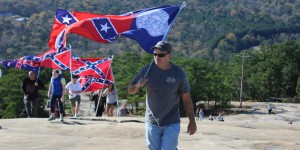
Protesters climb Stone Mountain where they say a monument honoring Martin Luther King Jr. would disrespect Confederate veterans.
JOHNNY KAUFFMAN WABE
The day began with a gathering of about 40 people in a Stone Mountain parking lot. Some people drank beer, talked Confederate history, and told the media gathered that a monument to King would be an affront to their heritage and a dishonor to Confederate veterans.
“I have no problem with what Martin Luther King did,” said Tara Brandau. “He has his own places, but that bell does not have nothing to do with the Confederacy.”
As the group mounted the granite outcropping with Confederate heroes carved in its side, they did not encounter any counter-protestors.
At the top, tourists gazed at the Confederate flags, and the people carrying them, some even asked for photos with the group.
Marissa Phipps said she was surprised when the Confederate supporters passed as she headed back to her car after jogging at the park.
“It’s sad and unfortunate,” she said.
Phipps lives in Dunwoody, Georgia, but she says as an African-American who grew up in Charleston, South Carolina, she’s used to seeing the Confederate flag.
“I’ve accepted it, and what you can you do? You can’t change people or their mindset, all you can do is love,” she said.
Phipps knows of others who don’t come to the park because of its history, and she said a monument to King would be a good idea.
“He stood for a lot of great things, peace, equality. I don’t see how anybody could be against that,” she said.
Last month the state-appointed Stone Mountain Memorial Association made public a proposal to put a replica Liberty Bell atop the mountain as a nod to King’s famous “I Have a Dream” speech.
Civil rights groups, like the NAACP, as well as Confederate groups, like the Sons of Confederate Veterans, both oppose the plan.
Civil rights groups say the bell would dishonor King’s legacy.
But activists who worked alongside King, like John Lewis, and Andrew Young, have voiced their support.
The Stone Mountain Memorial Association board meets Tuesday. They don’t plan to discuss the proposal for the monument to King. The board is scheduled to vote on a proposal for a potential exhibit to African-American soldiers who fought in the Civil War.
Protestors this weekend said they weren’t happy about that idea either.
–wabe.org
###
KANSAS: Memorial to Honor Civil War Soldiers on Both Sides Planned
WICHITA, Ks. — A Reconciliation Memorial telling the story of both the Union and Confederate armies has been designed to take the place of the Confederate flag that once flew at the plaza at Veterans Memorial Park.
The focal point of the memorial will be a gray granite 8-foot obelisk that will look similar to the Washington Monument in Washington, D.C.
The flag of the Confederate States of America once flew with other flags at Veterans Memorial Park in Wichita. (June 23, 2015) Mike Hutmacher File photo
The four-sided obelisk will tell the story of how both sides lost soldiers and what and why they were fighting.
The memorial, which is expected to cost $25,000, with an additional $10,000 for its base and instillation, will be placed on the east side of Veterans Memorial Park, adjacent to the flag pavilion on the north, according to Bryson Allen, chairman of the Veterans Memorial Park board of directors.
EVERY WAR OUR NATION HAS EVER FOUGHT IN HAS FORGIVEN ITS ENEMIES AND RECONCILED THE DIFFERENCES – EXCEPT IN THE CASE OF THE CIVIL WAR.
Bryson Allen, chairman of the Veterans Memorial Park board of directors
“Every war our nation has ever fought in has forgiven its enemies and reconciled the differences – except in the case of the Civil War,” Allen said.
Last week, Wichita Park Board members voted to permanently keep the Confederate flag from flying at Veterans Memorial Park. The flag was removed on July 2 by order of Mayor Jeff Longwell, who acknowledged then that he and City Council members received numerous e-mails and phone calls following the deadly shootings in June at a black church in South Carolina. The accused shooter posted pictures on social media of himself posing with the flag.
The park board also recommended replacing the Confederate flag with the Kansas flag in the flag pavilion.
The Kansas flag is appropriate to fly, said John Stevens – whose father was John S. Stevens, for whom the pavilion is named. Kansas was the 34th state to be accepted into the Union, just months before the nation was thrust into the Civil War. Kansas entered as a free state. The American flag with 34 stars only had one president who served under it – Abraham Lincoln.
The Confederate flag was originally placed in the Wichita pavilion in 1976 as part of the nation’s bicentennial.
It was time for it to come down, Stevens said.
THE KANSAS FLAG DOESN’T HAVE THE POLITICAL CONSEQUENCES THAT THE CONFEDERATE FLAG HAS COME TO HAVE.
John Stevens, for whose father the flag pavilion is named
“I didn’t think my father would like to have that (Confederate) flag up there,” Stevens said. “The Kansas flag doesn’t have the political consequences that the Confederate flag has come to have. … My dad was a veteran. I am very positive for veterans and what they have done for our country. But my dad’s name was on 100 percent of the park, and then the veterans came in and decided to rename the park and leave my dad’s name off of everything but the pavilion. If I can’t have a little bit of say as a family member, then it becomes an irritation.”
Stevens’ father, a veteran of World War II, served as a city commissioner from 1963 through 1976 and was mayor in 1966 and 1967. He died in 1976.
For at least three years, the Veterans Memorial Park board has wanted to create a Civil War reconciliation memorial, Allen said. It was first suggested by Phil Blake, a World War II veteran who for nearly two decades helped rescue dilapidated and forgotten war memorials across Wichita. He died a year ago.
“We were looking for an opportunity to bring it forward,” Allen said. “After the flag controversy, it seemed like the right time to present it to the mayor. He told us to get together with the park and recreation director, and it has been in the works ever since.”
The veterans group hopes to have the memorial installed in the park by May 21 – Armed Forces Day.
Longwell said Sunday that the city will help fund a portion of the memorial, but the rest will be raised by veterans through private donations.
“The reality is it was a group of veterans that worked out the proposal,” Longwell said. “It was veterans who have deep concerns for all veterans who have fought in every war. There isn’t a reconciliation memorial anywhere else like this in the country. I hope it catches on. It still honors the South and the North and shows the story and provides the opportunity to reconcile.”
TENNESSEE: Memphis Group Joins Effort to Indentify Lynching Sites
A local church-based group is working to locate and memorialize the site of every post-Civil War lynching in Shelby County.
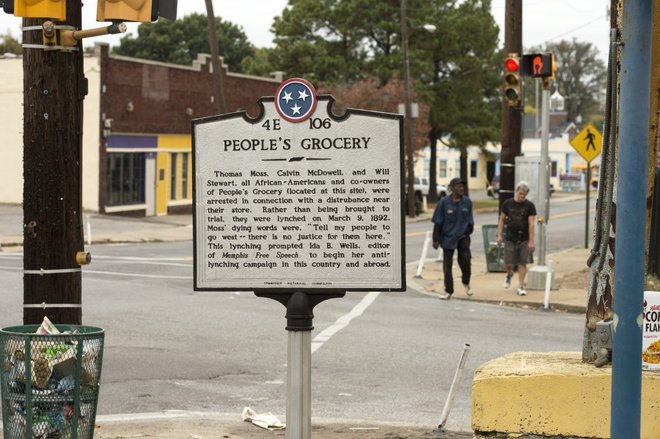
This Tennessee Historical Commission marker at the corner of Mississippi Blvd. and Walker Ave. commemorates the site where three African-American co-owners of People’s Grocery were lynched in 1892. The incident caused journalist Ida B. Wells to begin her campaign against lynching. (Brandon Dill/Special to The Commercial Appeal)
The group, which is calling itself “Responding to Racism,” is led by three retirees, all white and all members of First Congregational Church.
Rev. Randall Mullins, a retired United Church of Christ minister, sent an email to more than a dozen local clergy on Friday asking them to join the effort and recruit others.
“Holocaust survivor and author Elie Wiesel wrote, ‘Without memory there is no culture. Without memory there would be no civilization, no society, no future,'” Mullins said in his email.
“May we be bold and faithful to all the memory that keeps us human.”
The group includes retired professor Tom Carlson and retired oceanographer George Grider. Along with Mullins, they were inspired by the Alabama-based Equal Justice Initiative’s effort to identify the location of every lynching in the South from 1877-1950.
Bryan Stevenson, EJI’s founder, spoke in Memphis earlier this month. He was the keynote speaker for Facing History and Ourselves’ annual fundraising banquet.
He also met with the staff of the Shelby County Public Defender’s office as well as members of a local group working to commemorate the 150th anniversary of the 1866 race riot in Memphis.
“We cannot heal the deep wounds inflicted during the era of racial terrorism until we tell the truth about it,” Stevenson said when he was here.
“The geographic, political, economic, and social consequences of decades of terror lynchings can still be seen in many communities today and the damage created by lynching needs to be confronted and discussed. Only then can we meaningfully address the contemporary problems that are lynching’s legacy.”
Earlier this year, EJI released the results of five years of research that found 3,959 victims of “racial terror lynchings” in 12 Southern states.
Stevenson said EJI wants to collect soil samples from each site and place them at a national memorial in Montgomery that honors all lynching victims.
That includes 21 lynchings in Shelby County, the most in Tennessee and tied for 16th most in the South. Obion County in West Tennessee had 17. DeSoto County in Mississippi had 16.
Of the more than 200 historical markers in Shelby County, only one commemorates a lynching.
The “People’s Grocery” sign at the corner of Mississippi Boulevard and Walker commemorates the 1892 lynchings of store owners Thomas Moss, Calvin McDowell and Will Stewart.
“The lynching prompted Ida B. Wells, editor of the Memphis Free Speech, to begin an international anti-lynching campaign,” the sign notes. Those lynchings also are mentioned in a Beale Street marker honoring Wells.
Those 1892 lynchings are detailed in an anonymously written booklet called “Shelby County’s Shame.” The booklet, published more than 100 years ago, also describes the lynchings of one man in 1893, and six men in 1894.
“The rule of the white man in the South does not, cannot, be founded and perpetuated on mob law,” the anonymous author writes.
The local group also is relying on research conducted by EJI as well as Dr. Margaret Vandiver, a historian and retired criminology professor at the University of Memphis.
In her research, also cited by EJI, Vandiver found documented evidence for 15 lynchings in Shelby County from 1890-1930. Vandiver describes lynchings as “lethal social controls”
In her 2005 book, “Lethal Punishment Lynchings and Legal Executions in the South,” Vandiver described lynching as a cruel and capricious form of “lethal social control.”
That includes the 1917 lynching of Ell Persons, a black man accused of raping and then decapitating a 16-year-old white girl. Five thousand witnesses, drawn by newspaper announcements, saw Persons burned alive then cut to shreds near an old Wolf River bridge.
That lynching, the last one documented in Shelby County, led to the establishment of the Memphis branch of the NAACP.
Vandiver said efforts to document, mark and memorialize lynching here and across the South is more than an academic exercise.
“Recent social science studies find significant correlations between historic lynchings and a number of race related current social issues,” she said.
“Lynching remains more a wound than a scar (in historian Joel Williamson’s words) for the African-American community and any real conversation on race in this country will have to include deep and painful consideration of lynching.”
The “Responding to Racism” group doesn’t have a time line for its work, but Mullins said they plan to start with a “prayer service for truth” at Third and Adams, site of a historical marker for Confederate Gen. Nathan Bedford Forrest’s early Memphis home.
The marker notes Forrest’s “business enterprises made him wealthy” but fails to mention that he was a slave trader and slave owner.
“It is an insidious expression of racism, one that does not belong in our city,” Mullins said. “We see this as a first of many steps toward erecting new historical markers throughout Shelby County.”
–commercialappeal.com
###

